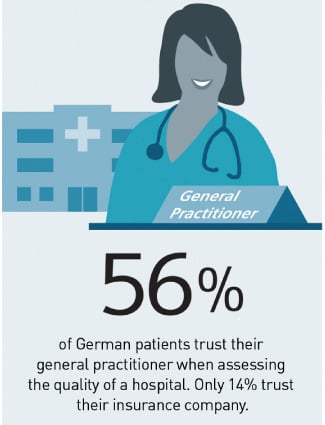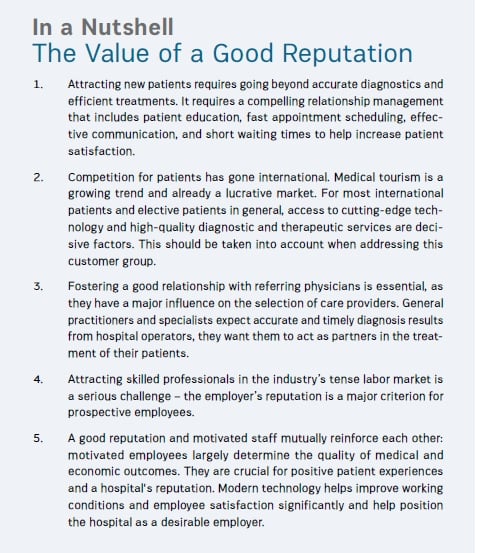HealthManagement, Volume 16 - Issue 3, 2016
HOW HEALTHCARE PROVIDERS CAN IMPROVE THEIR REPUTATION TO ATTRACT MORE PATIENTS AND QUALIFIED STAFF
A good reputation is an important asset for healthcare providers. Along with credible market positioning, it is vital for attracting self-reliant, quality-conscious, and cost-aware patient groups. Qualified and committed employees are key to a positive patient experience and hence to a provider’s reputation.
From Patients to Customers
“Where will I get the best treatment?” is an important question that patients ask with increasing frequency prior to hospital stays. The evolution into a consumer-driven healthcare industry with well-informed customers is desirable from a political point of view, especially in countries with expensive healthcare systems such as Germany and the U.S.
Insurance representatives call for increased transparency regarding quality of care and more focus on results in order to improve patient outcomes. They also advocate for quality driven remuneration models with quality-related premiums or discounts.1 To facilitate patients' choice of healthcare providers, some health insurance companies publish annual hospital quality reports online, making them broadly available to the public. Indicators of the quality of processes and outcomes are to be included in patient-friendly quality reports.
Medical Quality Counts
Despite increased efforts by hospital operators to score points with convenience features, medical quality is still the most important criterion when it comes to choosing between hospitals.2 However, many patients find it difficult to rate this, so general practitioners and specialists play a prominent role in the choice of a hospital. Fast and accurate diagnostic results, timely appointments, and smooth, IT -based data exchange are some of the assets with which hospital operators can significantly improve their reputation among this important, influential group.
A hospital’s economic basis also affects its reputation. According to a survey by consulting firm PwC, when hospitals face a poor financial situation, many patients suspect a negative impact on medical care or the condition of medical equipment. Modern equipment, for instance, allows for readily available and accurate diagnostic results, which can significantly help reduce waiting times, improve patient outcomes, or avoid ineffective treatments. All of this significantly increases patient satisfaction. For example, in Germany, large, well-equipped teaching hospitals tend to have the best reputation, followed by privately run hospitals. Both exceed municipal or church facilities by a wide margin.3

The Internet Crucially Shapes Reputation
Online review sites and social media platforms are rapidly becoming very important for a hospital’s reputation and its selection by partners – especially among younger, well-educated patients and potential employees. This is equally true for Europe, the U.S., and many emerging economies. More than a third of the Indian population, for example, use the Internet to search for health information, with similar percentages of younger, more educated people seeking health information online in Brazil, Mexico, and China.4
In Denmark, for example, customers grade hospitals online on a special website by giving them scores that range from one to five stars as if they were hotels, with service level indicators as well as actual results, including case fatality rates on certain diagnoses. In the U.S. too, patients and referring physicians can compare hospitals online – via the CAHPS Hospital Survey.5 The CAHPS results give hospital managers interesting ways to invest in patient satisfaction. According to the survey, a whopping 30% of all newly discharged patients would not unequivocally recommend their hospital.
Good Staff, Good Reputation – and Vice Versa
The CAHPS results show that open-minded, responsive staff significantly affect patient satisfaction and hospital reputation. Close and personal patient engagement can only be achieved through dedicated, satisfied employees.6 Investments in employee satisfaction seem to pay off financially. Research from Gallup indicates that committed or ‘engaged’ physicians are more productive and ensure considerably more recommendations. Gallup estimates the average annual increase in revenues at just under half a million dollars per doctor.7
The use of state-of-the-art technology for diagnosis, treatment, and information management can significantly increase employee satisfaction, which in turn improves patient experience and hospital reputation. Key starting points include improvements to the working environment through efficient IT -based processes that save staff time and allow more time for patient care, and training that empowers employees to make optimum use of technical equipment. Access to an extensive, cutting-edge database and accurate diagnostic results also support researchers with their studies and publications. This not only helps increase the reputation of a hospital as a healthcare provider, but also increases their standing as a desirable employer with attractive development prospects.
Attractive for Patients Around the World
Excellent and reasonably priced services, a good international reputation, and a focus on the needs of foreign patients are some of the ways successful hospital operators secure lucrative patient flows from abroad. Experts peg the global market volume for medical tourism at around $38.5 to $55 billion, based on approximately 11 million cross-border patients worldwide spending an average of $3,500-5,000 per visit.8 According to the OE CD, dental care, cosmetic surgery, elective surgery, and fertility treatment are particularly popular.9
Globally, only about one in eight patients is going abroad mainly for cheaper treatment.9 Instead, the majority of medical tourists want better medical care. According to a study by McKinsey, advanced technology, better quality of care, and quicker access to medically necessary therapies are the main motivations for medical tourism.8

References:
1. GKV, 14 Positionen für 2014, Reform der Krankenhausversorgungaus Sicht des GKV-Spitzenverbandes https://www.gkvspitzenverband.de/
2. Bertelsmann Stiftung und der Barmer/GEK, Gesundheitsmonitor 2012. Bürgerorientierung im Gesundheitswesen, http://gesundheitsmonitor.de
3. PwC, Umfrage Krankenhäuser, April 2014 www.pwc.de
4. Bain & Company, Health Care 2020
5. Hospital Consumer Assessment of Healthcare Providers and Systems, www.hcahpsonline.org
6. Gallup Business Journal, Why Hospitals must Surpass Patient Expectation, May 2014, www.gallup.com
7. Gallup Business Journal, Want to Increase Hospital Revenues? Engage Your Physicians June 2014, www.gallup.com
8. Patients Beyond Borders, 2015; www.patientsbeyondborders.com
9. WHO, Medical Tourism, 2013; www.who.int

